Unit 3 How do you get to school?知识点复习课件(共17张PPT)
文档属性
| 名称 | Unit 3 How do you get to school?知识点复习课件(共17张PPT) |  | |
| 格式 | zip | ||
| 文件大小 | 189.0KB | ||
| 资源类型 | 教案 | ||
| 版本资源 | 人教新目标(Go for it)版 | ||
| 科目 | 英语 | ||
| 更新时间 | 2022-08-09 12:11:21 | ||
图片预览


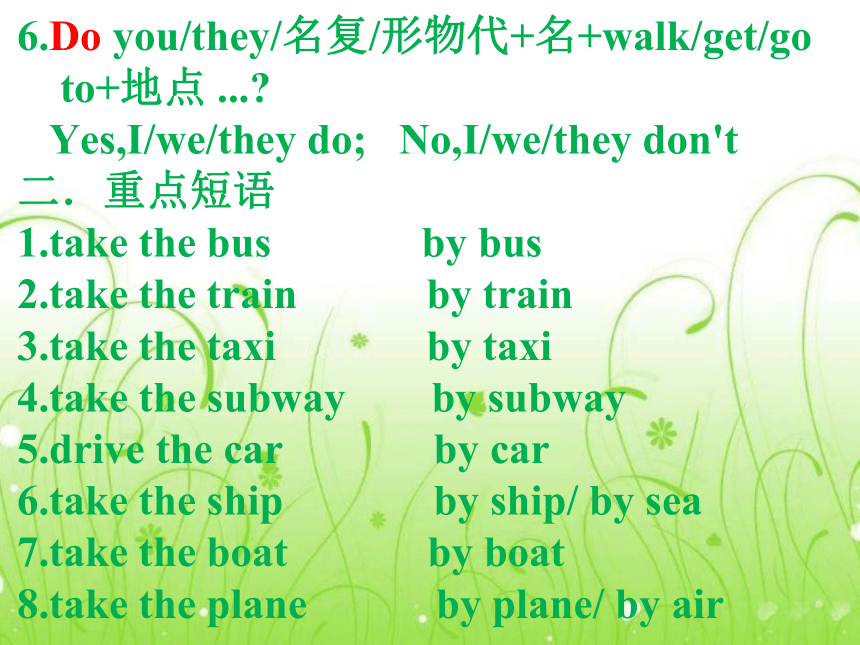
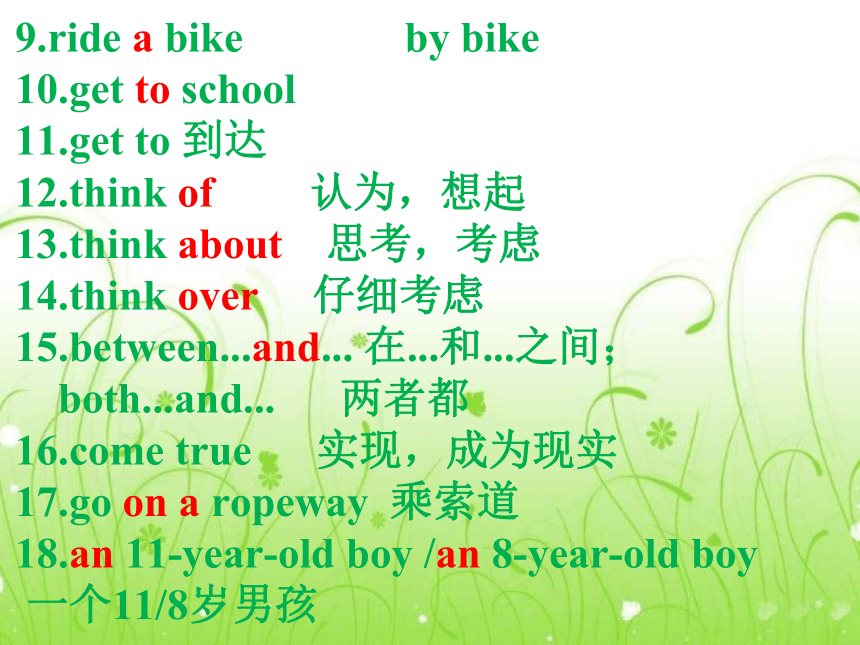
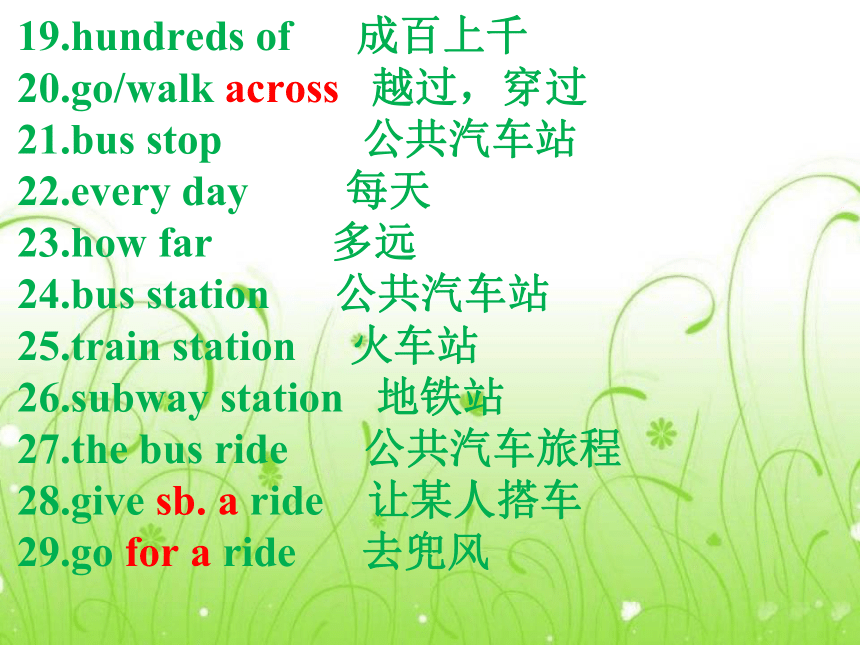
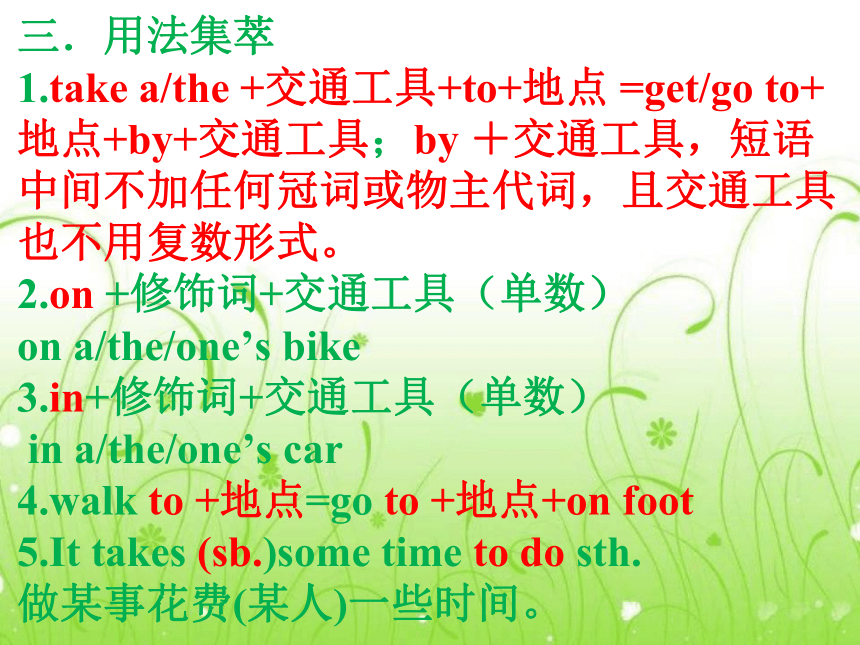
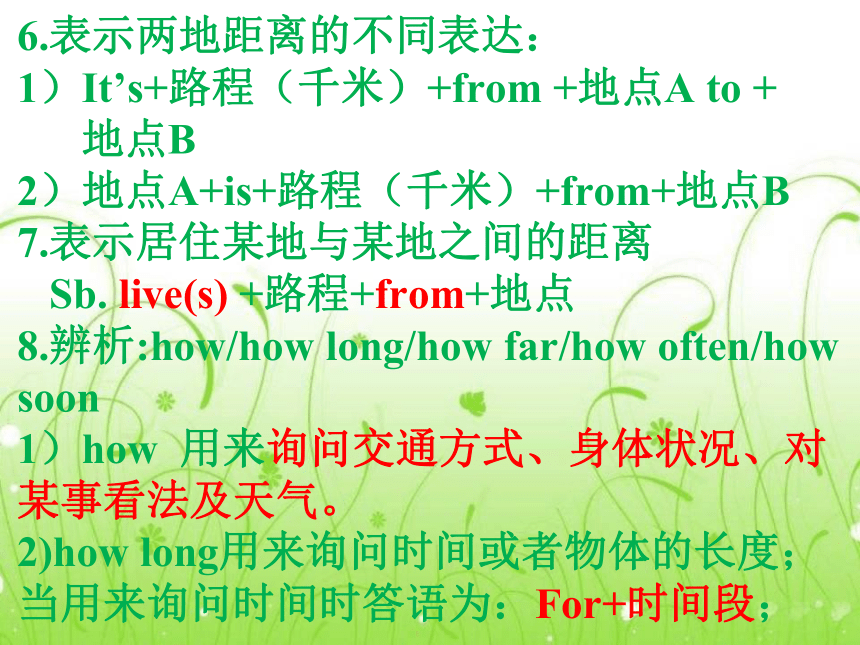
文档简介
(共17张PPT)
Unit3 How do get to school ?
Come on!
Boys and Girls!
一.固定用法
1. How do you/they/形物代+名复+ get to+
地点?
2.How does he/she/人名/形物代+名单+ get to+地点?
3.How long does it take to get to+地点?
It takes......
4. How far is it from A to B? It's......
5. Does he/she/人名/名单/形物代+名单+walk /get/go to+地点...?
Yes,he/she does; No,he/she doesn't
6.Do you/they/名复/形物代+名+walk/get/go
to+地点 ...
Yes,I/we/they do; No,I/we/they don't
二.重点短语
1.take the bus by bus
2.take the train by train
3.take the taxi by taxi
4.take the subway by subway
5.drive the car by car
6.take the ship by ship/ by sea
7.take the boat by boat
8.take the plane by plane/ by air
9.ride a bike by bike
10.get to school
11.get to 到达
12.think of 认为,想起
13.think about 思考,考虑
14.think over 仔细考虑
15.between...and... 在...和...之间;
both...and... 两者都
e true 实现,成为现实
17.go on a ropeway 乘索道
18.an 11-year-old boy /an 8-year-old boy
一个11/8岁男孩
19.hundreds of 成百上千
20.go/walk across 越过,穿过
21.bus stop 公共汽车站
22.every day 每天
23.how far 多远
24.bus station 公共汽车站
25.train station 火车站
26.subway station 地铁站
27.the bus ride 公共汽车旅程
28.give sb. a ride 让某人搭车
29.go for a ride 去兜风
三.用法集萃
1.take a/the +交通工具+to+地点 =get/go to+地点+by+交通工具;by +交通工具,短语中间不加任何冠词或物主代词,且交通工具也不用复数形式。
2.on +修饰词+交通工具(单数)
on a/the/one’s bike
3.in+修饰词+交通工具(单数)
in a/the/one’s car
4.walk to +地点=go to +地点+on foot
5.It takes (sb.)some time to do sth.
做某事花费(某人)一些时间。
6.表示两地距离的不同表达:
1)It’s+路程(千米)+from +地点A to +
地点B
2)地点A+is+路程(千米)+from+地点B
7.表示居住某地与某地之间的距离
Sb. live(s) +路程+from+地点
8.辨析:how/how long/how far/how often/how soon
1)how 用来询问交通方式、身体状况、对某事看法及天气。
2)how long用来询问时间或者物体的长度;当用来询问时间时答语为:For+时间段;
3)how far 用来询问距离,其答语为:
1)用长度表示it's+距离;
2)用时间表示
4)how often 用来询问频率副词,表示:多久一次;其答语:多为用次数表示多久一次;
5)how soon 表示:多久,常用一般将来时,其答语为:in+时间;
9.辨析get to, arrive 与reach
1)get to+地点 到达某地
eg:get to Beijing 到达北京
2)arrive at 到达(小地方);
eg:arrive at school 到达学校
arrive in 到达(大地方);
eg:arrive in Beijing 到达北京
3)reach 抵达( 及物动词,后直接加宾语) reach Beijing到达北京
10.辨析hundred 与hundreds of
1)hundred 前面有具体数字时,
用“ 基数词+hundred”表示“几百”。
2)hundreds of 成百上千的”,表示概数,此时不能与数词连用,但可以与many, several 等连用。
总结:hundred, thousand, million, billion 的用法,前有具体数字无s 无of;表示模糊概念有s 有of。
11.What do you think of... 相当于“How do you like... ”
用来询问对某事、某物或某人的看法。其结构为:
What do/does sb. think of... =
How do/does sb. like...
12.play with sb. 与某人一起玩耍
13.It is + adj. + for sb. + to do sth. 中的for 表示对象,意为“就……而言;对……来说”,句中的形容词是描述事物特征的。
14.It's +adj.+of sb.+to do sth.中的形容词是表示人的特点、性格或特征的。
15.There is+名单;There are+名复;
遵循就近原则;
Here is+名单;Here are+名复;
遵循就近原则;
16.辨析:many, much 与lots of
1)many 修饰可数名词复数;few/a few+可数名词复数;
2)much 修饰不可数名词;little/a little+
不可数名词;
3)lots of=a lot of 既可修饰可数名词复数,又可修饰不可数名词;some和any 双修;17.辨析:between 与among
1)between 一般用于两者之间;
2)among 表示三者或三者以上的人或物之间;
18.辨析11-year-old与11 years old
1)11-year-old 中间加连字符号,名词用单数,相当于形容词,修饰名词,放于句中;
2)11 years old 中间不加连字符号,名词用复数;放于be动词之后;
总结:基数词+名词+形容词;构成的复合形容词,常用来作定语。
中间加连字符号,名词用单数,相当于形容词,修饰名词,放于句中;
中间不加连字符号,名词用复数;放于be动词之后;
19.辨析 be afraid to do sth. 与 be afraid of (doing) sth.
1)be afraid to do sth.表示“害怕做某事”,即主语对做某事感到恐惧。
2)be afraid of (doing)sth. 表示主语内心不情愿做某事,即不希望发生某事,但自己不一定能避免
20.dream of “梦想,梦见”,后接动词时,要用动词的 ing形式;
21.Thank sb. for+doing sth. =
Thanks for+doing sth. 感谢某人做某事
22.stop to do sth. 停下来去做另一件事情;
stop doing sth. 停止正在做的事情;
stop sb. from doing sth. 阻止某人做某事;
23.be like sb. to sb.
24.be like “像...一样”,侧重人的“内在特征”,如品质、性格、品行等方面像;
What is sb. like “某人是什么样的?(内在)
look like “看起来像”,侧重人的外部特征,如外貌、体型等方面的像;
What do/does sb. like ?
某人看起怎么样?(外在)
25.辨析:leave与leave for
1)leave 后跟地点为“出发地”;
2)leave for 后跟地点为“目的地”
26.some of +代词宾格/名词复数;
“....中的一些”
many of+代词宾格/名词复数;
“....中的许多”
27.be far from 离...多远
be away from 离...多远
be+路程+from 离...多远
一.
Unit3 How do get to school ?
Come on!
Boys and Girls!
一.固定用法
1. How do you/they/形物代+名复+ get to+
地点?
2.How does he/she/人名/形物代+名单+ get to+地点?
3.How long does it take to get to+地点?
It takes......
4. How far is it from A to B? It's......
5. Does he/she/人名/名单/形物代+名单+walk /get/go to+地点...?
Yes,he/she does; No,he/she doesn't
6.Do you/they/名复/形物代+名+walk/get/go
to+地点 ...
Yes,I/we/they do; No,I/we/they don't
二.重点短语
1.take the bus by bus
2.take the train by train
3.take the taxi by taxi
4.take the subway by subway
5.drive the car by car
6.take the ship by ship/ by sea
7.take the boat by boat
8.take the plane by plane/ by air
9.ride a bike by bike
10.get to school
11.get to 到达
12.think of 认为,想起
13.think about 思考,考虑
14.think over 仔细考虑
15.between...and... 在...和...之间;
both...and... 两者都
e true 实现,成为现实
17.go on a ropeway 乘索道
18.an 11-year-old boy /an 8-year-old boy
一个11/8岁男孩
19.hundreds of 成百上千
20.go/walk across 越过,穿过
21.bus stop 公共汽车站
22.every day 每天
23.how far 多远
24.bus station 公共汽车站
25.train station 火车站
26.subway station 地铁站
27.the bus ride 公共汽车旅程
28.give sb. a ride 让某人搭车
29.go for a ride 去兜风
三.用法集萃
1.take a/the +交通工具+to+地点 =get/go to+地点+by+交通工具;by +交通工具,短语中间不加任何冠词或物主代词,且交通工具也不用复数形式。
2.on +修饰词+交通工具(单数)
on a/the/one’s bike
3.in+修饰词+交通工具(单数)
in a/the/one’s car
4.walk to +地点=go to +地点+on foot
5.It takes (sb.)some time to do sth.
做某事花费(某人)一些时间。
6.表示两地距离的不同表达:
1)It’s+路程(千米)+from +地点A to +
地点B
2)地点A+is+路程(千米)+from+地点B
7.表示居住某地与某地之间的距离
Sb. live(s) +路程+from+地点
8.辨析:how/how long/how far/how often/how soon
1)how 用来询问交通方式、身体状况、对某事看法及天气。
2)how long用来询问时间或者物体的长度;当用来询问时间时答语为:For+时间段;
3)how far 用来询问距离,其答语为:
1)用长度表示it's+距离;
2)用时间表示
4)how often 用来询问频率副词,表示:多久一次;其答语:多为用次数表示多久一次;
5)how soon 表示:多久,常用一般将来时,其答语为:in+时间;
9.辨析get to, arrive 与reach
1)get to+地点 到达某地
eg:get to Beijing 到达北京
2)arrive at 到达(小地方);
eg:arrive at school 到达学校
arrive in 到达(大地方);
eg:arrive in Beijing 到达北京
3)reach 抵达( 及物动词,后直接加宾语) reach Beijing到达北京
10.辨析hundred 与hundreds of
1)hundred 前面有具体数字时,
用“ 基数词+hundred”表示“几百”。
2)hundreds of 成百上千的”,表示概数,此时不能与数词连用,但可以与many, several 等连用。
总结:hundred, thousand, million, billion 的用法,前有具体数字无s 无of;表示模糊概念有s 有of。
11.What do you think of... 相当于“How do you like... ”
用来询问对某事、某物或某人的看法。其结构为:
What do/does sb. think of... =
How do/does sb. like...
12.play with sb. 与某人一起玩耍
13.It is + adj. + for sb. + to do sth. 中的for 表示对象,意为“就……而言;对……来说”,句中的形容词是描述事物特征的。
14.It's +adj.+of sb.+to do sth.中的形容词是表示人的特点、性格或特征的。
15.There is+名单;There are+名复;
遵循就近原则;
Here is+名单;Here are+名复;
遵循就近原则;
16.辨析:many, much 与lots of
1)many 修饰可数名词复数;few/a few+可数名词复数;
2)much 修饰不可数名词;little/a little+
不可数名词;
3)lots of=a lot of 既可修饰可数名词复数,又可修饰不可数名词;some和any 双修;17.辨析:between 与among
1)between 一般用于两者之间;
2)among 表示三者或三者以上的人或物之间;
18.辨析11-year-old与11 years old
1)11-year-old 中间加连字符号,名词用单数,相当于形容词,修饰名词,放于句中;
2)11 years old 中间不加连字符号,名词用复数;放于be动词之后;
总结:基数词+名词+形容词;构成的复合形容词,常用来作定语。
中间加连字符号,名词用单数,相当于形容词,修饰名词,放于句中;
中间不加连字符号,名词用复数;放于be动词之后;
19.辨析 be afraid to do sth. 与 be afraid of (doing) sth.
1)be afraid to do sth.表示“害怕做某事”,即主语对做某事感到恐惧。
2)be afraid of (doing)sth. 表示主语内心不情愿做某事,即不希望发生某事,但自己不一定能避免
20.dream of “梦想,梦见”,后接动词时,要用动词的 ing形式;
21.Thank sb. for+doing sth. =
Thanks for+doing sth. 感谢某人做某事
22.stop to do sth. 停下来去做另一件事情;
stop doing sth. 停止正在做的事情;
stop sb. from doing sth. 阻止某人做某事;
23.be like sb. to sb.
24.be like “像...一样”,侧重人的“内在特征”,如品质、性格、品行等方面像;
What is sb. like “某人是什么样的?(内在)
look like “看起来像”,侧重人的外部特征,如外貌、体型等方面的像;
What do/does sb. like ?
某人看起怎么样?(外在)
25.辨析:leave与leave for
1)leave 后跟地点为“出发地”;
2)leave for 后跟地点为“目的地”
26.some of +代词宾格/名词复数;
“....中的一些”
many of+代词宾格/名词复数;
“....中的许多”
27.be far from 离...多远
be away from 离...多远
be+路程+from 离...多远
一.
同课章节目录
- Unit 1 Can you play the guitar?
- Section A
- Section B
- Unit 2 What time do you go to school?
- Section A
- Section B
- Unit 3 How do you get to school?
- Section A
- Section B
- Unit 4 Don't eat in class.
- Section A
- Section B
- Unit 5 Why do you like pandas?
- Section A
- Section B
- Unit 6 I'm watching TV.
- Section A
- Section B
- Review of Units 1-6
- Unit 7 It's raining!
- Section A
- Section B
- Unit 8 Is there a post office near here?
- Section A
- Section B
- Unit 9 What does he look like?
- Section A
- Section B
- Unit 10 I'd like some noodles.
- Section A
- Section B
- Unit 11 How was your school trip?
- Section A
- Section B
- Unit 12 What did you do last weekend?
- Section A
- Section B
